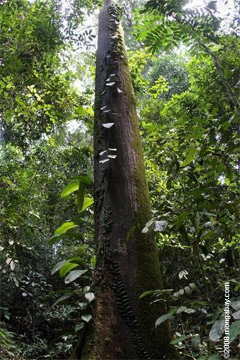Could felling trees and burying them help fight global warming?
Could felling and burying trees help fight global warming?
mongabay.com
April 30, 2008
Could cutting down trees and burying them help fight global warming? An article in this week’s issue of New Scientist suggests so.
Ning Zeng, an atmospheric scientist at the University of Maryland in College Park, tells New Scientist that thinning forests and burying “excess wood” in a manner in which its didn’t decay could sequester enough carbon to offset all of our fossil-fuel emissions.
“Zeng gives an example of a plot of 1 square kilometre (100 hectares), with the excess wood from 1 hectare of woodland buried deeper than 5 metres and down to 20 metres,” writes Richard Lovett of New Scientist, referring to Zeng’s research published in Carbon Balance and Management. “He calculates that this could sequester 1 tonne of carbon per hectare — using that land to grow trees would sequester 1 to 5 tonnes, depending on the age of the forest and the type of tree.”

|
“He estimates that offsetting all of the world’s current emissions would be achievable with a workforce of one million people — substantially fewer than those already employed in the forestry industry in the US alone,” Lovett continues. “Even so, to offset all our emissions, most of the world’s forests would have to run a wood burial scheme.”
New Scientist notes that Zeng’s idea is not a new one — ancient indigenous groups used a similar approach known as biochar to enrich the nutrient-poor soils of the Amazon rainforest.
“More than 500 years ago Amazonian people were creating almost pure carbon by smouldering their domestic waste and letting it work its way into the soil. This earth, known as terra preta (‘black earth’) remains to this day,” Lovett writes. “Ancient farmers had no idea that they were sequestering carbon, of course, but they did know that adding biochar to the soil hugely increased its quality.”
Lovett cites a modern example in hydrothermal carbonization, a process which chars organic material under pressure. He says the technique could eventually be used on an industrial scale and may qualify for carbon credits, assuming it could avoid generating methane, another potent greenhouse gas.
Related
Amazon farming technique may fight global warming
(4/11/2008) Fifteen hundred years ago, tribes people from the central Amazon basin mixed their soil with charcoal derived from animal bone and tree bark. Today, at the site of this charcoal deposit, scientists have found some of the richest, most fertile soil in the world. Now this ancient, remarkably simple farming technique seems far ahead of the curve, holding promise as a carbon-negative strategy to rein in world hunger as well as greenhouse gases.
Biochar fund to fight hunger, energy poverty, deforestation, and global warming
(3/10/2008) Biopact, a leading bioenergy web site, has announced the creation of a “Biochar Fund” to help poor farmers improve their quality of life without hurting the environment.
Restoring soil carbon can reverse global warming, desertification and biodiversity loss
(2/21/2008) Restoring the ability of soil to store carbon by promoting native grasses and vegetation can help reverse global warming, desertification and biodiversity loss, says an Australian researcher.
_Ancient Amazonian technology could save the world
(5/17/2007) Terra preta, the ancient charcoal-based soil used by ancient Amazonians to create permanently fertile agricultural lands in the rainforest, is getting serious consideration as a means to fight global warming and meet domestic energy demand, reports an article in Scientific American.







